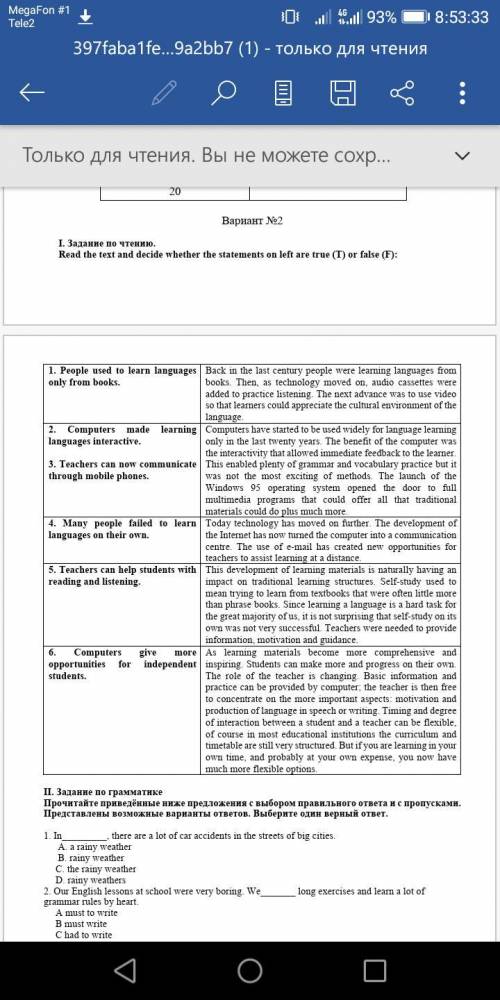Read the text and decide whether the statements on left are true (T) or false (F): 1. People used to learn languages only from books. Back in the last century people were learning languages from books. Then, as technology moved on, audio cassettes were added to practice listening. The next advance was to use video so that learners could appreciate the cultural environment of the language. 2. Computers made learning languages interactive. 3. Teachers can now communicate through mobile phones. Computers have started to be used widely for language learning only in the last twenty years. The benefit of the computer was the interactivity that allowed immediate feedback to the learner. This enabled plenty of grammar and vocabulary practice but it was not the most exciting of methods. The launch of the Windows 95 operating system opened the door to full multimedia programs that could offer all that traditional materials could do plus much more. 4. Many people failed to learn languages on their own. Today technology has moved on further. The development of the Internet has now turned the computer into a communication centre. The use of e-mail has created new opportunities for teachers to assist learning at a distance. 5. Teachers can help students with reading and listening. This development of learning materials is naturally having an impact on traditional learning structures. Self-study used to mean trying to learn from textbooks that were often little more than phrase books. Since learning a language is a hard task for the great majority of us, it is not surprising that self-study on its own was not very successful. Teachers were needed to provide information, motivation and guidance. 6. Computers give more opportunities for independent students. As learning materials become more comprehensive and inspiring. Students can make more and progress on their own. The role of the teacher is changing. Basic information and practice can be provided by computer; the teacher is then free to concentrate on the more important aspects: motivation and production of language in speech or writing. Timing and degree of interaction between a student and a teacher can be flexible, of course in most educational institutions the curriculum and timetable are still very structured. But if you are learning in your own time, and probably at your own expense, you now have much more flexible options.

Другие вопросы по теме Английский язык
Популярные вопросы
- Записать предложения, расставить знаки препинания, подчеркнуть грамматические...
2 - 7. Знайдіть кути чотирикутника, якщо вони пропорційні числам 2, 3, 4,...
2 - у результаті спалювання 31.5 г вуглеводню одержали вуглекислий газ аса...
2 - Первое число на 5 больше второго. Известно, что 0,2 первого числа равны...
3 - 4 TASK You work for the city council. There is no more space to throw...
1 - АЛЯРМ! СУПЕР МЕГА Que fait la fée ? Elle saute ou elle tourne ? Elle...
2 - Подскажите как сложить бизнес план 5 клас укр мова...
1 - Какие особые потребности есть у людей с ограниченными возможностями?...
3 - Реши уравнение z+12/7=1/4....
3 - Повидомлення : Література стародавнього Риму ...
3
2. Computers made learning languages interactive. (T) - The text mentions that computers have made language learning interactive by providing immediate feedback to learners. This has allowed for plenty of grammar and vocabulary practice.
3. Teachers can now communicate through mobile phones. (F) - The text does not mention anything about teachers communicating through mobile phones. It mainly focuses on the use of computers and the internet for language learning.
4. Many people failed to learn languages on their own. (T) - The text states that learning a language on one's own, without the assistance of a teacher, was often unsuccessful due to the difficulty of language learning. Teachers were needed to provide information, motivation, and guidance.
5. Teachers can help students with reading and listening. (T) - The text mentions that teachers play a role in assisting students with reading and listening, as self-study from textbooks was not very successful in the past.
6. Computers give more opportunities for independent students. (T) - The text states that as learning materials become more comprehensive and inspiring, students can make more progress and work independently. This allows teachers to focus on motivation and language production.
Overall, the statements on the left are mostly true according to the information provided in the text.